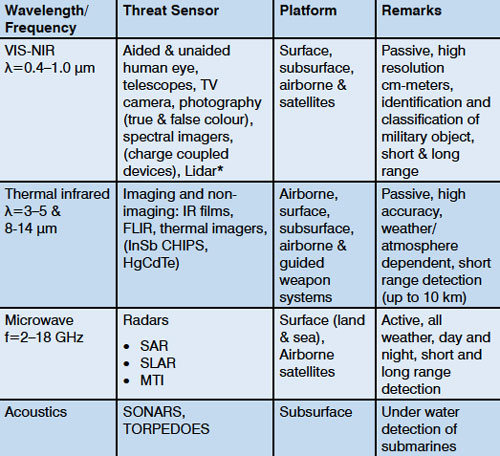| Posted: Jan 30, 2015 | |
Nanotechnology and nanomaterials for camouflage and stealth applications (page 1 of 5) |
|
| (Nanowerk Spotlight) This article briefly describes how nanomaterials and nanotechnology can be useful in the strategic area of camouflage and stealth technology. The threat perception is one of the most important parameters, which decides the requirement of camouflage measures that need to be taken. The section on threat perception briefly describes about various sensors and platforms from where those sensors can be operated for the purpose of surveillance, detection and identification of military objects. Prominent nanomaterials, which can find applications in futuristic stealth have been discussed. | |
| Introduction | |
| The word camouflage has its origin in the French word camoufler which means to disguise. In English dictionary, the word meaning was initially referred to concealment or disguise of military objects in order to prevent detection by the enemy. In earlier days, specifically before 20th century, the only sensor available to detect was human eye and so camouflage was confined to the visible light only. The rapid development of sensor technology outside the visible range has forced to use new definition and terminologies for camouflage. | |
| Modern definition of camouflage may be given as “delay or deny detection of a military target by detectors operating over multispectral wavelength region of electromagnetic spectrum or non-electromagnetic radiation e.g., acoustic, magnetic, etc. Multispectral camouflage, low-observability, countermeasures, signature management, and stealth technology are some of the new terminologies used now instead of camouflage. In any case, reflections and emissions of electromagnetic radiation are reduced or tailored through the use of carefully designed shapes of military targets and the use of special materials as add-ons on the targets. | |
| The concept of camouflage is as old as nature, and it has been an integral part of it. All animals small or big, are found to employ several methods of concealment and disguise for self -preservation, both in defence and offence. Although there may not be a counterpart in the present day arm race to each and every strategy adopted by animals in nature, these very principles, however, form the basis of man-made camouflage methods while incorporating the elements of concealment, disguise, or deception. | |
| The technological explosion in the latter half of the 20th century specifically in the fields of electronics, computers, materials, and sensor technology have brought in unimaginable advances in military hardware, weapons, weapon controls, and delivery systems, mobility, reconnaissance, surveillance and target acquisition systems. Simultaneously, along with these developments, the role of countermeasures has become increasingly important, demanding improvements in the existing countermeasures and development of new methods and techniques. | |
| In modern warfare, stealth technology is applied mostly to aircrafts and combat weapons. Stealth technology can improve the survivability and performance of aircrafts and weapons to gain the upper hand. Stealth technology involves the minimization of acoustic, optical, infra-red, and electromagnetic signatures. Among them, the minimization of electromagnetic signature, particularly in microwave region, is the most important. It can be realized in several ways which include stealth shaping design, radar absorbing material (RAM), and radar absorbing structures (RAS)1. | |
| Camouflage and particularly multispectral camouflage is a highly challenging subject for a number of reasons. Firstly, it requires integration of many disciplines of science and technology ranging from psychology, agriculture, physics, chemistry, math, mechanical-, electrical-, electronic-, computer engineering etc. One has to deal with the heterogeneity of war theaters i.e. land, sea or air; detection avoidance by high resolution detectors seeking signatures of targets over multispectral wavelengths of EM spectrum together with the non- availability of open literature on the advancements in the area due to the classified nature of the subject make it all the more challenging. | |
| Threat Perception and Analysis | |
| There has been an extensive development in the field of sensors and signal processing technologies that has lead to the availability of sensors over the entire EM spectrum and nearly perfect battlefield intelligence in real time. The enemy employs a variety of sensors to detect and identify soldiers, equipment and supporting installations besides the intelligent means to collect information. Since World War II, tactical camouflage, concealment and deception designers have been forced to create solutions that could address more than the visible spectrum of detection. This evolution is a result of increasingly sensitive sensor devices and technologies that have been developed over time. These sensor devices include divergent means such as: enhanced optical range through advanced visual scopes, radar, night vision, and thermal imagery detection. Further advances have led to technologies like forward looking infrared ('FLIR') imaging technology and shortwave infrared ('SWIR') sensing technologies that make invisible spectrum detection even better. | |
| Technologies and products are now merging these various sensor technologies together. To provide effective camouflage solution it is essential to know about these sensors, which may be working in ultraviolet (UV), visible and near infrared (NIR), IR, LASERS, MW acoustic, or multispectral/hyper spectral; platforms used for their deployment, and their capabilities. The details of such sensors and platforms are given in Table 1. | |
 |
|
| Table 1: Sensors used for surveillance reconnaissance and guided weapon systems. | |
| Continue to next page (2 of 5) | |
|
Become a Spotlight guest author! Join our large and growing group of guest contributors. Have you just published a scientific paper or have other exciting developments to share with the nanotechnology community? Here is how to publish on nanowerk.com. |
|
